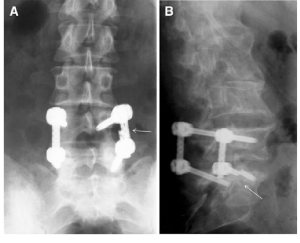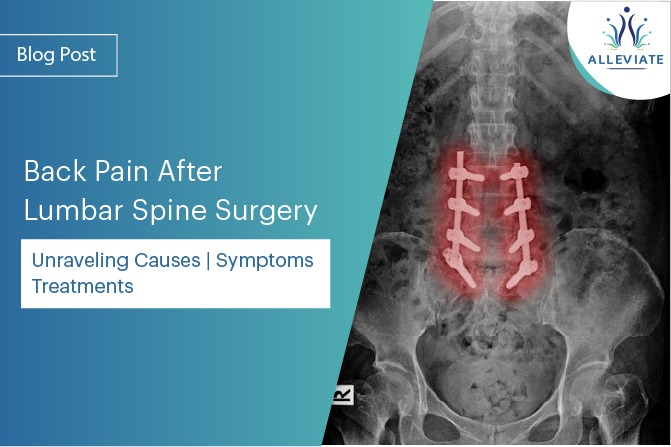Introduction
Undergoing spine surgery is a significant step towards finding relief from chronic back issues. However, the journey to recovery is not always seamless, and persistent back pain post-surgery can be disheartening. In this comprehensive guide, we explore the causes, symptoms, and innovative treatments for back pain after spine surgery, with a special focus on image-guided interventions.
Causes of Back Pain After Spine Surgery
Failed Back Surgery Syndrome (FBSS)
- FBSS occurs when surgery does not provide the expected relief or leads to new or persistent pain.
- Causes : Incomplete decompression, recurrent disc herniation, nerve damage, or the development of scar tissue.
Adjacent Segment Disease (ASD)
Adjacent segment degeneration post lumbar spine surgery
- ASD refers to the degeneration or pain that arises in segments adjacent to the surgically treated area. Such as the adjacent facet joints or the sacroiliac joint on the same side
- Causes : Changes in biomechanics post-surgery, increased stress on adjacent discs.,adjacent facet joints and sacroiliac joint.

Scar Tissue Formation
- The formation of scar tissue around nerves or surgical sites can lead to pain.
- Causes : Natural healing response post-surgery can result in the formation of adhesions.
Hardware Issues

Two types of Hardware Failure were seen. Rupture of the flexible rod and rupture of pedicle screws. a Rupture of the flexible rod, b rupture of one caudal pedicle screw
- Discomfort or pain can arise from issues related to implants or hardware used during surgery.
- Causes: Hardware failure, malposition, or irritation of surrounding tissues.
Infection
- Postoperative infections can lead to persistent pain and discomfort.
- Causes: Bacterial or viral infections at the surgical site.
Common Symptoms of Back Pain After Spine Surgery
Persistent or Recurrent Pain
- Ongoing discomfort or the return of pain after an initial period of relief post-surgery.
- Potential Causes: Incomplete decompression, recurrent disc herniation, or scar tissue formation.
Radiating Pain or Numbness
- Pain that extends into the limbs, often accompanied by numbness or tingling.
- Potential Causes: Nerve impingement, adjacent segment disease (ASD), or ongoing compression.
Limited Range of Motion
- Difficulty moving the spine as freely as before surgery, stiffness, or reduced flexibility.
- Potential Causes: Ongoing inflammation, muscle imbalances, or hardware-related issues.
New Onset Weakness
- Weakening of muscles in the back or limbs not present before surgery.
- Potential Causes : Nerve damage during surgery, adjacent segment disease, or hardware complications.
Localized or Sharp Pain
- Sharp or localized pain at the surgical site or adjacent areas.
- Potential Causes: Scar tissue formation, hardware issues, or nerve irritation.
Pain During Specific Activities
- Discomfort that intensifies during certain movements or activities.
- Potential Causes: Mechanical issues, muscle imbalances, or complications from the surgery.
Understanding Image-Guided Treatments
Image-Guided Epidural Steroid Injections
- Overview: Precision injection of steroids into the epidural space guided by imaging.
- Benefits: Targets inflammation at the specific site, providing localized pain relief
PRP Injections (Platelet-Rich Plasma)
- Overview: Concentrated platelets from the patient’s blood are injected into the affected area.
- Mechanism: Growth factors in PRP promote tissue repair and reduce inflammation
- Benefits: Enhanced healing, reduced pain, and improved tissue regeneration.
Prolotherapy
- Overview: Injection of a solution (often dextrose) to stimulate ligament and tendon healing.
- Mechanism: Induces controlled inflammation, encouraging tissue growth and strengthening
- Benefits: Enhanced stability, reduced pain, and improved function.
Radiofrequency Ablation (RFA)
- Procedure: Utilizes heat generated by radiofrequency waves to disrupt pain signals from irritated nerves.
- Mechanism: Temporarily interrupts pain signals, offering relief
- Benefits: Precision in targeting specific nerves, minimizing damage to surrounding tissues.
Spinal Cord Stimulation (SCS)
- Procedure: Implantation of a device delivering electrical impulses to the spinal cord.
- Mechanism: Modulates pain signals, reducing the perception of pain
- Benefits: Customizable settings for individual pain patterns, enhancing effectiveness.
Image-Guided Facet and Sacroiliac Joint Injections
- Procedure: Targeted injection of local anesthetic and steroid into the facet and sacroiliac joints guided by imaging.
- Mechanism: Reduces inflammation in the joints, alleviating pain
- Benefits: Precision in reaching affected areas, optimizing therapeutic outcomes.
The Role of Image Guidance in Precision Treatments
Enhanced Precision and Accuracy
Imaging techniques like fluoroscopy or ultrasound guide the exact placement of injections.Ensures the medication or solution reaches the targeted area, optimizing treatment efficacy.
Real-Time Visualization
Physicians can visualize the spine and surrounding structures in real time. Allows for on-the-spot adjustments to ensure the most accurate delivery of treatment.
Minimized Risk of Complications
Image-guided procedures reduce the risk of inadvertent damage to surrounding tissues.Enhances the safety profile of treatments, minimizing potential complications.
Minimally Invasive Decompression
Surgical technique addressing residual compression without extensive surgery.Targeted decompression with reduced recovery time.
Physical Therapy and Rehabilitation
Tailored exercises to improve strength, flexibility, and posture.Enhances overall spine health and function.
Visit Alleviate Pain Clinic, Bengaluru
If persistent back pain is impacting your post-surgery journey, Alleviate Pain Clinic in Bengaluru offers specialized care and cutting-edge treatments. Our experienced team combines the expertise of pain management specialists, spine surgeons, and physical therapists to create a personalized plan addressing your unique needs.
Our state-of-the-art facility emphasizes image-guided interventions, ensuring precision in targeting the root cause of your pain. From epidural steroid injections to spinal cord stimulation, we utilize the latest advancements in pain management to provide effective relief.
Conclusion
Back pain after spine surgery is a complex challenge, but with the right strategies, relief is attainable. Alleviate Pain Clinic in Bengaluru stands at the forefront of pain management, offering individualized care and advanced treatments. Don’t let persistent pain hinder your recovery—schedule a consultation with our expert team and take the first step towards a pain-free future.
References
Image taken from https://www.researchgate.net/figure/ Two-types-of- Hardware-Failure -were-seen-Rupture-of- the-flexible- rod-and-rupture-of _fig1_44624148





